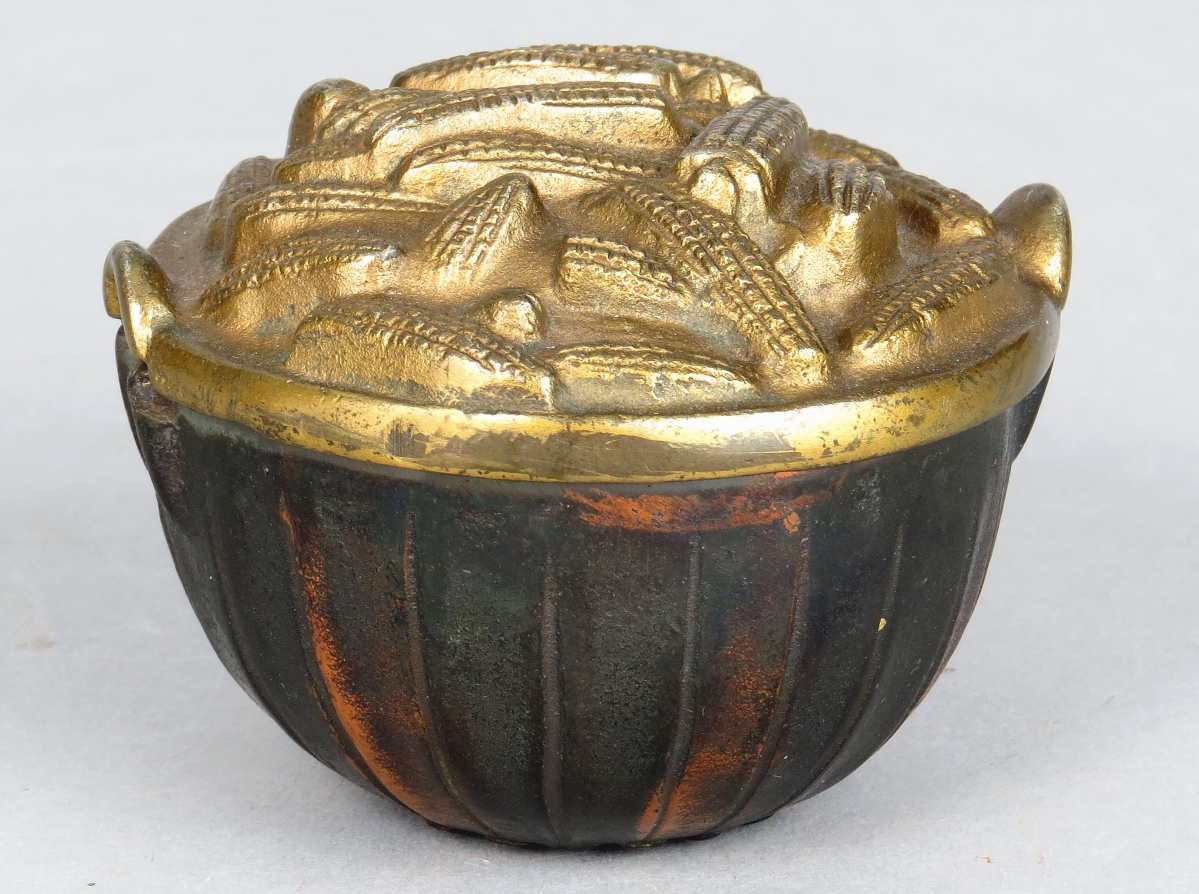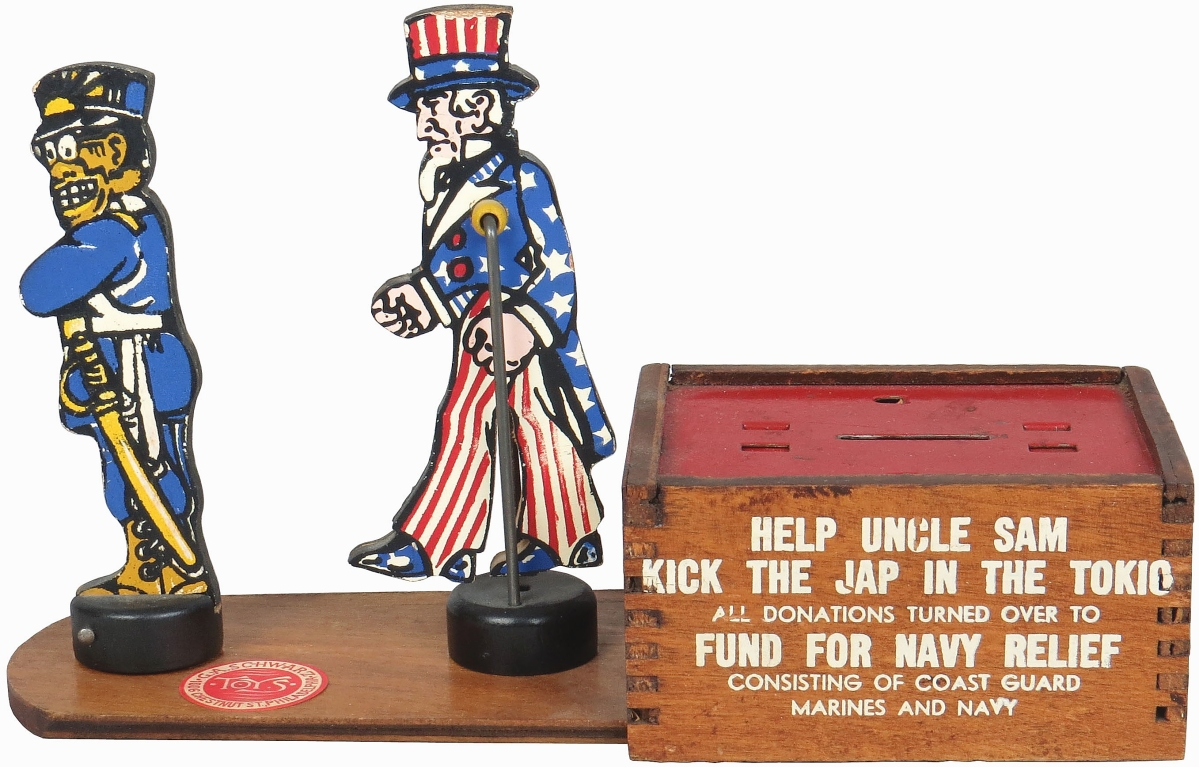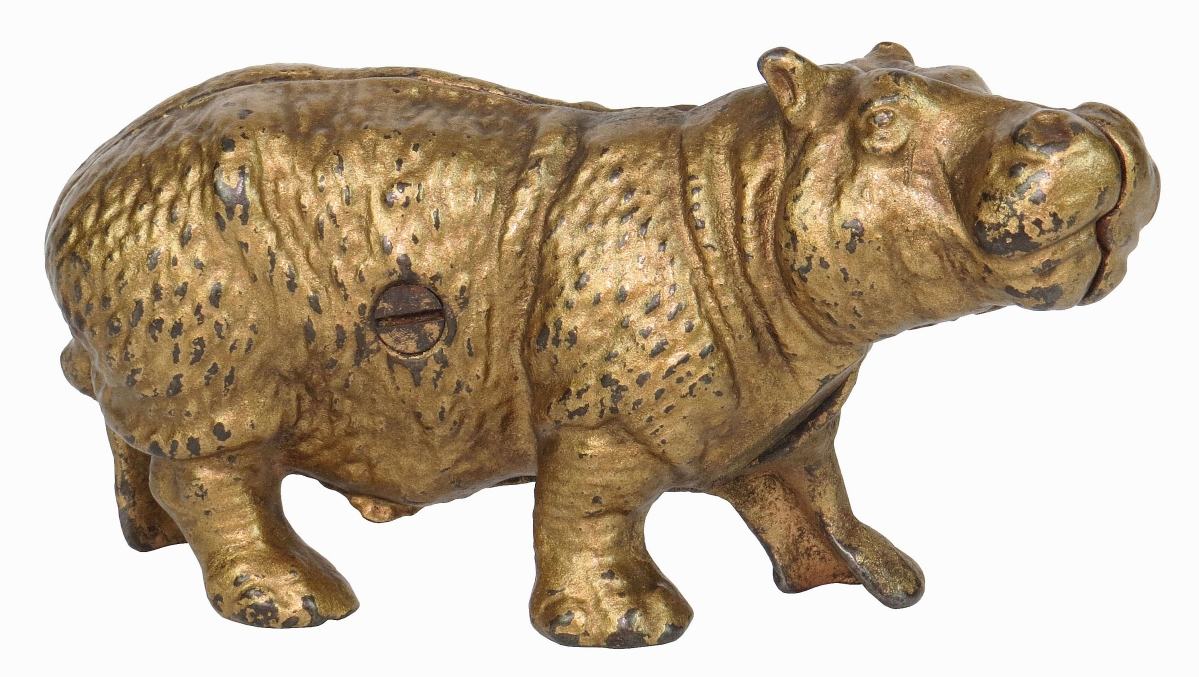
The Bushel of Corn bank topped the sale at $7,475, going home with a collector from Iowa who was bidding in the room. It was marked on the bottom “Copyright by J.M. Harper, 1907.”
Review by W.A. Demers, Photos Courtesy BP Auctions
ARLINGTON HEIGHTS, ILL. – It was wartime at the Double Tree Hotel on April 24. Figuratively speaking, that is, as BP Auctions conducted a sale to disperse a portion of Guy Williams’ historic war and home front collection of still and mechanical banks. The live auction was combined with online and left bids. There were nearly 300 bidding via online platform with another 35 dedicated bank collectors in the room. “The sale was very successful,” said Bob Peirce, who co-owns BP Auctions with his wife Shirley, still putting in 12-hour days packing up items to be shipped to successful bidders days after the sale. “There were a lot of happy buyers and several very high prices.”
The auction house uses the ballroom in the hotel to display the lots and conduct the auction. “People can pick up and examine the banks,” Peirce noted, adding that the nearly 600 lots comprising this sale represented the tip of the iceberg. “Bank collectors never have a small collection,” he quipped, and there will be more sessions to come over the next couple years. Peirce should know about the size and breadth of such collections as he began his own amassing of banks 40 years ago.
Williams embarked on his collecting mission more than 40 years ago and in that time acquired what may be considered the best and most complete collection of war-related banks in the United States. Among the banks in his collection were war-related bubble banks, carved coconut banks, advertising banks, as well as lead, tin and cast iron still banks. Not only did he collect American examples of war banks, but his collection also included many German, French, Japanese and English war banks.

The Kick the Jap in the Tokio mechanical bank, an early 1940s war bank made of wood, was rare, the only complete example known and sold for $5,520.
Cast iron defied gravity in the form of a Bushel of Corn bank. Topping the sale at $7,475, it was marked on the bottom “Copyright by J.M. Harper, 1907.” A Chicago, Ill., native, James M. Harper designed and copyrighted some 20 still banks and had them produced by the Chicago Hardware Foundry Company. All of his banks display his name and copyright dates ranging from 1902 – 1909. Not much is known about him except that his banks are beautifully designed and extremely rare. A collector from Iowa who was in the room carried it home.
Not surprisingly, wartime banks and coin-ops were decidedly racist in terms of portraying US enemies. It is the nature of human conflict to dehumanize such foes, so we have the Kick the Jap in the Tokio mechanical bank. An early 1940s war bank made of wood; it was rare, the only complete example known. It was not the inserted coin that did the deed but a lever and rubber band that allowed Uncle Sam’s leg to move. Selling for $5,520, the bank featured block letter printing on the side of the collection box that read “Help Uncle Sam Kick the Jap in the Tokio.” All donations turned over to fund for Navy relief consisting of Coast Guard, Marines and Navy.” A sticker on the top of the base showed the bank to be produced by “G.A. Schwarz, 1006 Chestnut Street, Philadelphia,” and a label on the underside of the base gave general care and repair instructions. Three of Gustavus Schwarz’s brothers (Henry, F.A.O. and Richard Schwarz) operated toy stores in Baltimore, New York and Boston.
Fetching $4,485 was a cast iron Hippo bank rated “E,” a rating, Peirce explained, that means there are only about 20 known examples. Cast iron still banks, i.e., banks with no mechanical action like the Bushel of Corn and Hippo, were popular in the first quarter of the Twentieth Century. The friendly Hippo manufactured by A.C. Williams apparently pleased the 27 bidders who took it past its $2/3,000 estimate. The company produced its first still bank in 1899. By the 1920s the line included a large variety of still banks in the shapes of characters, animals, trolleys, airships, clocks, buildings, etc. The company also manufactured toys and mechanical banks. A.C. Williams temporarily suspended production during World War II but no longer manufactured still banks and it ceased operation in 1977. Of course, on eBay you can still find Hippo still banks made in the 1990s, but not like this one.
Also rated “E” and of cast iron was a Wisconsin War Eagle bank featuring an uncharacteristically posed eagle (not spread-winged) and the legend “Old Abe.” It earned $2,300.
Another figural still bank, but of both lead and tin, portrayed a German soldier standing by a chest, which acted as a bank. He stood 4½ inches high and, providentially, the bank came with its key. It was bid to $3,565. It had been estimated just $800-$1,200.
Along with the still banks being sold, the collection also included coin-operated banks and machines. Listed in mint condition, a wood Freedmen’s Bureau bank, one of the rare few examples with a label on back, went out at $3,105. The tiny three-drawer bureau carried the legend on its front “Now You See It. Now You Don’t,” and its full label on the back read “Freedmen’s Bureau/Manufactured by L. Childs & Co./Springfield, Mass./Patent Applied For.”
An electroplated cast iron Husky bank realized $2,185, while a lead bank in the form of a bust of Germany’s “Von Hindenburg,” circa 1915, that had been in the Andy and Susan Moore collection took $2,128.
Prices given include the buyer’s premium as stated by the auction house. The next sale for BP Auctions will be a two-day auction on September 24-25. For information, call 262-797-7933 or email rpeirce15@gmail.com.













